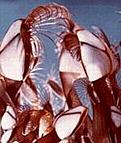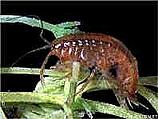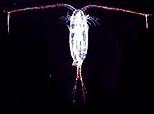
(water flea) |

(gooseneck barnacle) |
Subphylum CRUSTACEA(tree/traits: Brusca & Brusca 2003 p. 580) |

(mantis shrimp) |

(amphipod) |

(calanoid copepod) |

(lobster) |

(water flea) |

(gooseneck barnacle) |
Subphylum CRUSTACEA(tree/traits: Brusca & Brusca 2003 p. 580) |

(mantis shrimp) |

(amphipod) |

(calanoid copepod) |

(lobster) |
====1============================= Cl. Remipedia
<<==C==|
| ===3========================== Cl. Cephalocarida
=2==|
| ==5======================= Cl. Branchiopoda (fairy shrimp, water fleas, etc.)
=4==|
| ==7=================== Cl. Maxillopoda (copepod, ostracod, barnacle, etc.)
==6=|
| ==8============== SubCl. Phyllocarida (Or. Leptostraca)
=Mal=|
| ==9======= SubCl. Hoplocarida (mantis shrimps)
=Eumal=|
| ==11= SupOr. Peracarida (mysids, amphipods, isopods, etc.)
=10==|
==12= SupOr. Eucarida (krill, shrimps, lobsters, crabs, etc.)
TRAITS SUPPORTING EACH CLADE (** plesiomorphic- a primitive state, not unique to clade):
|
b) 1° antennae uniramous** c) 2° antennae biramous d) mandible is simple (gnathobasic) e) sessile (non-stalked), compound eyes** f) many similar, biramous, phyllopodous thoracic limbs** g) telson with rami h) nauplius larvae b) raptorial mouth appendages c) segment #6= maxilliped d) many similar trunk segments (no trunk tagmata) with paddle-like biramous legs e) pre-antennal process f) eyes lost b) reduced number of body segments b) abdomen of 11 segments c) segment #5= leg-like d) compound eyes lost b) abdomen has fewer than 9 segments (trunk segment number & limbs vary greatly) b) abdomen has fewer than 8 segments b) abdomen has fewer than 5 segments c) unique naupliar eyes & loss of lateral compound eyes d) genital appendages on 1st abdominal somite of male |
b) abdomen of 7 segments + telson c) carapace covers head & thorax** d) 1° antennae biramous in adult e) stalked eyes in adult f) male gonopore on segment 8, female on segment 6 b) abdomen of 7 segments + telson** c) second maxilla like thoracic limbs** d) similar, phyllopodous thoracic limbs** b) thoracic limbs stenopodous c) long muscular abdomen d) telson lacks rami e) uropods + telson make a tail fan b) limbs of first 5 thoracic segments uniramous & subchelate c) thorax segment #2 with very large subchela d) moveable rostrum e) gills on pleopods b) thoracic oostegites form brood chamber c) pre-juvenile manca stage b) 3 pair maxillipeds (except euphausids) c) last 5 pair thoracic limbs uniramous (except euphausids) d) well-developed gills under carapace (except euphausids) e) brood eggs on pleopods (except euphausids) |